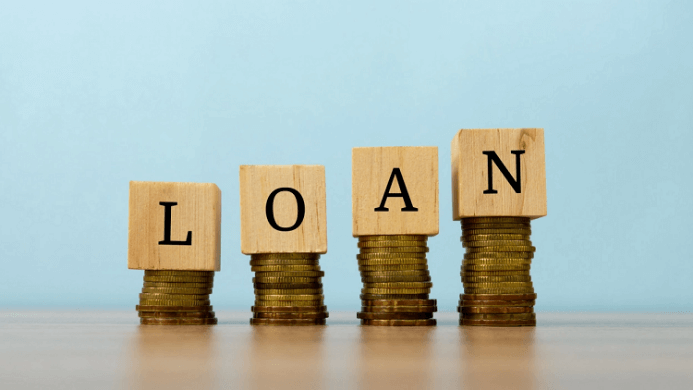Loan- DefinitionWe might only sometimes have the money to do some tasks or make specific purchases. People, businesses, and organizations decide to borrow money from lenders in particular circumstances. 
When a lender gives money to a person or business with a specific promise or presumption that the borrower would repay the borrowed funds with specific added benefits, such as an interest rate, this is referred to as lending or accepting a loan. The principal, interest rate, and Term are the three components of a loan, and the loan's Term is the length of time it will be in effect. Since banks and respectable non-banking financing companies (NBFCs) must follow government regulations, most of us choose to borrow money from them. Lending is one of the primary financial services provided by any bank or NBFC. Different Types of Loans1. Based on the Security Provideda. Secured Loans: For these loans, the Borrower must pledge property as security for the lent money. If the Borrower cannot make loan payments, the bank reserves the right to use the pledged collateral to reclaim the unpaid debt. These loans have much lower interest rates than unsecured loans. b. Unsecured Loans: Unsecured loans are ones for which collateral is optional before the loan can be repaid. The bank evaluates the Borrower's credit history, previous interactions with them, and other variables before deciding whether or not to approve the loan. Due to the need for a mechanism to recover the loan funds if the Borrower defaults, these loans may have higher interest rates. 2. Based on the Purposea. Education Loan: The Borrower may use education loans to further their studies. Undergraduate and graduate degrees and any diploma or certification program from an accredited school or university may be counted as the course. To access the funding, you must have the organization's admission pass. There is funding available for both domestic and foreign courses. b. Personal Loan: You can apply for a personal loan anytime if you need help with your financial flow. To pay off an old debt, fund a trip, pay for a down payment on a car or property, pay for an unforeseen medical bill, or to purchase pricey furnishings or technology, among other things, one may take out a personal loan. Personal loans may be made available depending on the applicant's credit history and lender history. c. Vehicle Loan: Lending money to buy two- and four-wheelers is a regular practice. Both new and used versions of the four-wheeled vehicle are possible. The lender will use the vehicle's on-road pricing to calculate the loan amount. You should be ready with a down payment to buy the car, given that loans rarely offer 100% financing. Until full payment is received, the lender will maintain vehicle possession. d. Home Loan: Homes and apartments can be purchased, built, renovated, or repaired with the help of house loans. Also, land can be purchased to build houses or apartments. In this scenario, the lender will hold the property until all payments have been received before transferring possession to the legitimate owner. 
3. Based on the Pledged Assetsa. Gold Loan: Many banks and lenders will pay cash when the Borrower guarantees actual gold, whether jewelry, gold bars, or coins. The lender carefully examines the purity of the gold before weighing it and determining the amount offered. Any use of the funds is permitted. To be fully returned after the period and to allow the Borrower to reclaim the gold, the loan must be paid back in equal monthly installments. The lender reserves the right to confiscate the gold to compensate for losses if the Borrower doesn't complete the payments on time. b. Loan against assets: People and companies can borrow money by pledging assets such as real estate, insurance policies, certificates of deposit, mutual funds, shares, and bonds, similar to pledging gold. The lender will present a loan with an available margin based on the value of the pledged assets. At the end of the term, the Pledged Assets will be available for the Borrower to take possession of. Otherwise, the lender may sell the assets to repay the outstanding debt. Lenders Consider a few Key Factors before Approving Your Application1. Credit Score The lender will consider your credit score when deciding whether to approve or deny your application at first. This is especially accurate when it comes to unsecured loans. The lender looks at the Borrower's repayment history to evaluate if the Borrower can make payments on time or if they will default because a borrower's credit score reflects their credit history. After the necessary analysis, the lender will determine whether to authorize the loan. 2. Income and Employment History Your loan application will likely be granted or denied based on your employment history, monthly or yearly income, and credit score. Depending on your salary and the stability of your income, as evidenced by a long history of regular employment, the lender may or may not be satisfied that you can repay the loan. The lender assumes that even if you are self-employed, your firm has been running well for the past few years and that its turnover is sufficient. 3. Debt-to-Income Ratio A solid salary is vital, but so is your debt-to-income ratio. You will only be given a new loan if your monthly income is Rs. 1 lakh and your debt repayment obligations total Rs. 75,000. This is so that you can spend the remaining money for home expenses. Because of this, regardless of your income, you need to have a low debt-to-income ratio to give lenders the impression that you have enough monthly money to make repayments and cover living expenses. 4. Collateral The lender may determine the interest rate that will be charged on your loan using the collateral you submit and its current market value. Giving collateral to the lender will make the transaction more secure, fostering better trust and resulting in a cheaper interest rate. Unsecured loans have infamously high-interest rates, which is well-known. 5. Down Payment Because you have money saved and have successfully carried out your down payment savings plan, the lender will have more confidence in you. As the down payment increases, demand for the loan amount declines. Features and Benefits of Loans
Eligibility for LoanThere are several criteria to satisfy to be eligible for a loan, depending on the type you're searching for. Generally speaking, you can also check your eligibility by using the following straightforward criteria:
Documents RequiredSalaried applicants:
Self-Employed applicants:
Loan EMI CalculatorThe monthly payment to the lender and the overall interest can be calculated using a loan EMI calculator. You only need to enter the numbers for principal Amount (P), Period (N), and Interest rate (R) to calculate the EMI applicable to your loan amount. How to Apply for a Loan?Applying for a bank loan is simpler than you would expect. However, given that you must repay the loan later, you should be mindful of your financial status before applying for one. Understanding your needs is the first step. If you decide this is the best course of action, you can either visit the bank and speak with the loan manager or skip all that and submit an online application. Step 1:Choose the lender you wish to borrow from and verify your eligibility based on your research. Step 2:Visit a bank branch or official website to apply for a loan. Step 3:Submit or upload any required supporting documentation. Step 4:After processing your application, the bank will contact you to let you know where they stand in the specified length.
Next TopicLungs Definition
|
 For Videos Join Our Youtube Channel: Join Now
For Videos Join Our Youtube Channel: Join Now
Feedback
- Send your Feedback to [email protected]
Help Others, Please Share










